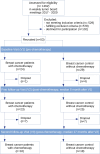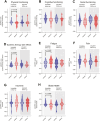Chemotherapy-induced cognitive impairment and its long-term development in patients with breast cancer: results from the observational CICARO study
- PMID: 39403794
- PMCID: PMC11881063
- DOI: 10.1093/oncolo/oyae268
Chemotherapy-induced cognitive impairment and its long-term development in patients with breast cancer: results from the observational CICARO study
Abstract
Background: Chemotherapy-induced cognitive impairment (CICI) is a well-recognized side effect of breast cancer treatment. However, prospective long-term evaluations of CICI using standardized neuropsychological tests are scarce.
Patients and methods: This prospective longitudinal cohort study investigated cognitive dysfunction and its impact on quality of life and everyday functioning in patients with breast cancer receiving first-line chemotherapy compared to patients with breast cancer without chemotherapy. Assessment occurred prior to chemotherapy, postchemotherapy (median 6 months), and 2-3 years later. We used standardized neuropsychological tests, questionnaires, and scales to assess patients' quality of life and functioning. Additionally, serum analysis for neurodegenerative markers and autoantibodies was conducted.
Results: We included n = 53 patients. Overall cognitive function declined statistically significantly (P = .046) postchemotherapy compared to control patients, mostly driven by a reduced figural memory (P = .011). Patients who received chemotherapy showed a greater reduction in quality of life (increased fatigue symptoms, P = .023; reduced Karnofsky index, P < .001); however, without a statistically significant effect on cognitive decline. The neurodegenerative markers Neurofilament light chain (NfL) and phosphorylated Neurofilament heavy chain (pNfH) increased statistically significantly (P < .001) postchemotherapy and pNfH correlated with overall cognitive function. After 2-3 years, both cognitive performance and quality of life were comparable between chemotherapy-treated and control patients.
Conclusion: Our findings suggest that chemotherapy statistically significantly contributes to overall cognitive dysfunction in patients with breast cancer, which disappears after 2-3 years, indicating a recovery in both objectively measurable cognitive function and subjective quality of life. Future research should examine larger sample sizes and explore screening indicators, particularly pNfH.
Keywords: CICI; breast cancer; cognitive; impairment; neurotoxicity; quality of life.
© The Author(s) 2024. Published by Oxford University Press.
Conflict of interest statement
The authors declare that the research was conducted in the absence of any commercial or financial relationships that could be construed as a potential conflict of interest.
Figures




References
Publication types
MeSH terms
Grants and funding
LinkOut - more resources
Full Text Sources
Medical

